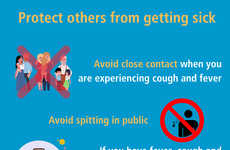
The 'We Can't End AIDS Until We End the Drug War' Chart is Telling
Jennifer Gosnell — July 30, 2012 — Social Good
References: visual.ly
The 'We Can't End AIDS Until We End the Drug War' infographic speaks volumes about the current condition of the world today. With an ongoing battle against AIDS, drugs and many other prevalent issues, the world can be a scary place.
One in three people who get infected with HIV outside of Sub-Saharan Africa can root the cause back to sharing a syringe. Places that have sterile syringe access programs have greatly reduced rates of HIV and AIDS infection. While this may seem like backwards thinking -- shouldn't we be eliminating drug use altogether? -- the fact remains that for the current condition of the world, this is the most feasible option. Not only does it lower the rates of AIDS, but it also lowers the cost alongside. The program costs approximately $500 per person per year, whereas treatment for AIDS for a year is over $34,000.
Further, as was experienced in Seattle, those with access to this type of program were also five times more likely to check themselves voluntarily into a drug treatment program for a long-term solution.
One in three people who get infected with HIV outside of Sub-Saharan Africa can root the cause back to sharing a syringe. Places that have sterile syringe access programs have greatly reduced rates of HIV and AIDS infection. While this may seem like backwards thinking -- shouldn't we be eliminating drug use altogether? -- the fact remains that for the current condition of the world, this is the most feasible option. Not only does it lower the rates of AIDS, but it also lowers the cost alongside. The program costs approximately $500 per person per year, whereas treatment for AIDS for a year is over $34,000.
Further, as was experienced in Seattle, those with access to this type of program were also five times more likely to check themselves voluntarily into a drug treatment program for a long-term solution.
Trend Themes
1. Sterile Syringe Access Programs - Implementing sterile syringe access programs to combat the spread of HIV/AIDS can lead to lower infection rates and cost savings in healthcare.
2. Voluntary Drug Treatment Programs - Increasing access to sterile syringe programs can also encourage individuals to seek voluntary drug treatment programs for long-term solutions.
3. Cost-effectiveness of Prevention Programs - Investing in prevention programs, like sterile syringe access, can be a more affordable option compared to treating HIV/AIDS in the long run.
Industry Implications
1. Healthcare - The healthcare industry can explore integrating sterile syringe access programs to reduce the spread of HIV/AIDS and provide cost-effective solutions.
2. Public Health - Public health organizations can support and advocate for the implementation of sterile syringe programs as part of comprehensive HIV/AIDS prevention strategies.
3. Drug Rehabilitation - The drug rehabilitation industry can collaborate with sterile syringe access programs to offer voluntary drug treatment options and support long-term recovery from substance abuse.
2.4
Score
Popularity
Activity
Freshness























